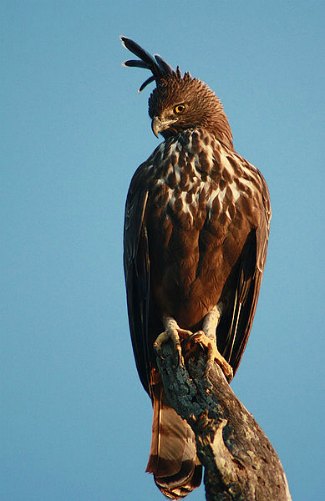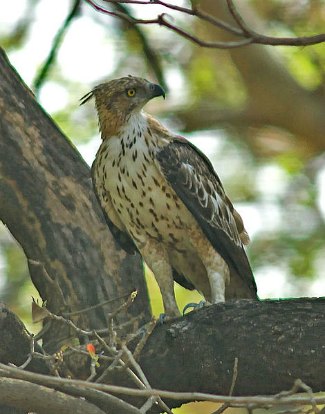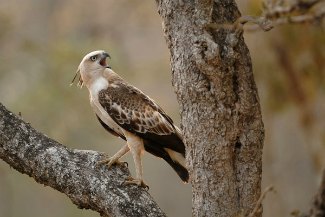Crested Hawk Eagle - Nisaetus cirrhatus
By Mylittlefinger, CC-BY-SA-3.0, via Wikimedia Commons
Family: Accipitridae
Genus: Nisaetus
Species: N. cirrhatus
Subspecies: N. c. andamanensis, N. c. ceylanensis (Ceylon Hawk Eagle), N. c. cirrhatus, N. c. limnaeetus,
N. c. vanheurni
Crested Hawk Eagles are large raptors with varying color morphs and several subspecies that occur in southern and southeast Asia, throughout forested areas.
Physical Description:
Crested Hawk Eagles come in a range of crested, crestless, dimorphic (having a pale and a dark morph), and monomorphic (having only one morph) forms, depending on the subspecies.
N. c. cirrhatus, the nominate species, has a long crest up to 10-14 cm long and one morph form. N. c. andamenensis is smaller, also monomorphic, and has a short crest around 5 cm long. N. c. ceylanensis is also small in size, has a single morph form, but its crest is around 10 cm long. N. c. limnaeetus is dimorphic with a very short crest 1-3 cm long. N. c. vanheurni is the smallest of all the subspecies, has no crest, and is monomorphic.
In general, dark morph Crested Hawk Eagles have brown wings tipped with black with 4-5 darker bars. The breast and underside are streaked with brown, and the undertail and thighs are thinly barred with white. The floppy crest is long, consisting of around 4 feathers. The chin and throat are white, and the eyes are yellow. The legs are long and feathered, and the long tail has thin bars.
Pale morphs—existing only when the bird is dimorphic, such as subspecies N. c. limnaeetus—are dark brown from above with pale wing coverts. The head and neck are rufous with some black streaking, and the underside from the chest to the belly and flanks is white to buff with black and dark brown streaks.
Crested Hawk Eagle calls are shrill, repetitive screams. They are more vocal during the breeding season. Listen to a recording.
Size:
Length: 57-79 cm
Wingspan: 127-138 cm
Weight: 1.3-1.9 kg
By Dr. Tarak N Khan, CC-BY-2.0, via Wikimedia Commons
Habitat and Distribution:
They live in deciduous, semi-evergreen, and logged forest, along with savannah woodland, tea plantations, cultivated regions, and even along the edges of suburban areas. They usually live from 0-1,500 meters above sea level, but are known to occupy habitat as high as 2,200 m. Pairs remain in the same territory all year, although they do not hunt together. They are irruptive or local migrants, and juveniles disperse from their parents' breeding areas.
Crested Hawk Eagles are found throughout southern and southeast Asia, in India, Sri Lanka, the Andaman Islands, Philippines, Borneo, and the Indonesian islands Sumatra, Java, and the Greater Sundas. Their range spans from 30°N to 9°S.
Diet and Hunting:
Crested Hawk Eagles take a range of prey, including birds up the size of chickens, small mammals, snakes, and lizards. They perch in an exposed location to hunt, usually high up; occasionally they choose someplace lower, such as on a fencepost or in the crown of a tree. They then swoop down to catch their prey on the ground, although birds are sometimes caught in trees.
Reproduction:
Breeding displays consist of soaring and calling, although they do not have the elaborate sky dances of some other raptors. The breeding season is from November-May in southern India and January-February in the Himalayan foothills.
The nest is 95 cm-1.05 m across, and 35 cm-1.2 m deep. It is made out sticks and lined with leaves, and often placed in the fork of a tree. One white, rufous-spotted egg is laid and incubated for 35-44 days. Fledging takes 65-70 days.
Conservation:
Crested Hawk Eagles are the most widespread and common Asian hawk eagle, but the individual subspecies have much smaller ranges and are under threat from shooting and habitat loss. Subspecies N. c. andamanensis may have a range of less than 6,475 km², and N. c. vanheurni only 1,600 km². N. c. ceylanensis inhabits 65,000 km², however, and N. c. cirrhatus and N. c. limnaeetus even larger areas. The entire species has been evaluated as Least Concern by BirdLife International.
Taxonomy:
Genus Nisaetus was formerly lumped with Spizaetus; however, molecular studies showed Asian hawk eagles to be part of a different lineage than that of New World hawk eagles (Spizaetus), and therefore were split into the new genus Nisaetus. N. cirrhatus is a sister species to N. lanceolatus (Sulawesi Hawk Eagle).
Subspecies:
There are five subspecies: N. c. andamanensis lives in the Andaman islands, N. c. ceylanensis (Ceylon Hawk Eagle) in Sri Lanka, N. c. cirrhatus in India south of Rajasthan and along the Gangetic plain, N. c. limnaeetus in northern India, Nepal, Myanmar, Indochina, and the Malay peninsula, and N. c. vanheurni in Sumatra.
Other Names:
Ceylon Hawk Eagle, Changeable Hawk Eagle, Crested Hawk Eagle, Marsh Hawk Eagle, Lysbuget Høgeørn (Danish), Indische Kuifarend (Dutch), Välu-tuttkotkas (Estonian), Jalokotka (Finnish), Aigle huppé (French), Haubenadler (German), Spizaeto variabile (Italian), Kawarikumataka (Japanese), Burung Lang Hindek (Malay), Vekselskogørn (Norwegian), Wojownik indyjski (Polish), Águila Azor Variable (Spanish), Indisk tofsörn (Swedish).
Video of a Crested Hawk Eagle:
References:
http://avibase.bsc-eoc.org/species.jsp?avibaseid=2C0FA6E3E4B0795E
http://avis.indianbiodiversity.org/fauna-of-british-india-2nd-ed-vol-v-1928/ceylon-crested-hawk-eagle-spizaetus-cirrhatus-ceylanensis.html
BirdLife International (2011) Species factsheet: Nisaetus cirrhatus. Downloaded from http://www.birdlife.org on
10/11/2011.
Global Raptor Information Network. 2011. Species account: Crested Hawk-eagle Nisaetus cirrhatus. Downloaded from
http://www.globalraptors.org on 10 Nov. 2011
http://ibc.lynxeds.com/species/changeable-hawk-eagle-spizaetus-cirrhatus
http://www.planetofbirds.com/accipitriformes-accipitridae-crested-hawk-eagle-nisaetus-cirrhatus
Ferguson-Lees, James, and Christie, David A. Raptors of the World. Houghton Mifflin Company, 2001.


